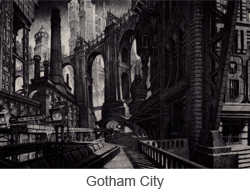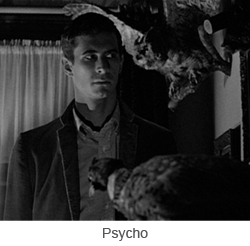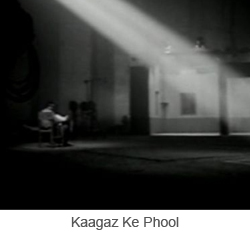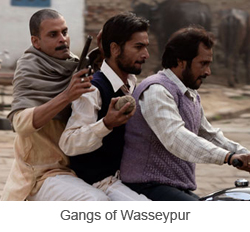|
Reality and expression
Unlike most of the other cinemas of the world Indian cinema did not approach the medium as an extension of photography; this may have had far reaching consequences upon the importance attached to it as 'cinema' internationally. It is because of its origins in photography that film art has become inconceivable without an appreciation of the realist aesthetic. There are a large number of ways in which the notion of realism has been understood but the most useful definition is perhaps that it is akin to a frame around an ongoing reality. The frame fixed onto a photograph is different from the one used for a painting in that the frame of the photograph masks a reality, of which whatever is pictured is only a portion – like the ten percent of an iceberg which shows above water. The frame of a painting, in contrast, contains everything the painting is about. The earliest debate in cinema is between its documentary aspect as represented by the Lumiere brothers and its fictional/illusionary aspect as represented by Georges Melies, and this developed into the two ends of a range in cinema focusing on the reality of the raw material (realism) and the director’s ability to manipulate or modify this reality in the service of expression (expressionism).
 Before I go ahead I should perhaps clarify certain aspects which may be regarded as confusing about this debate. In the first place ‘expressionism’ as the antithesis of ‘realism’ should not be confused with German Expressionism, which has formal peculiarities. German Expressionism is the name given to a body of films which proliferated in the silent era – marked by chiaroscuro lighting and spatial distortion - and best exemplified by Robert Wiene’s The Cabinet of Dr Caligari (1920). Expressionism in the more common sense relates to every kind of cinematic device which draws attention to the construction of cinema rather than to the elements of reality that go into it. The French theorist and critic Andre Bazin, for instance, regarded silent Soviet cinema - notably the films of Sergei Eisenstein - as ‘expressionist’ although the Soviet film-makers regarded their own films as ‘realist’, first and foremost. The justification from the Soviet side is that the film-makers were not simply engaged in portraying ‘reality’ but believed that cinema could assist in reconstituting it. It should be clear from this that political film-makers with clear ideological leanings – like the Brazilian Glauber Rocha – became more ‘expressionist’ in some sense in their later films which were not ‘frames around an ongoing reality’ but tried to reconstitute reality in the service of political expression. Since narrative cinema - however ‘realistic’ - fashions the recorded material in some way and inevitably uses bits of reality no matter how much the film-maker is devoted to personal expression, ‘realism’ and ‘expressionism’ are not mutually exclusive territories; all films are positioned somewhere in between and differences are a matter of degree. It may be useful at this juncture to provide instances of some devices in mainstream or genre films which may be termed broadly ‘expressionistic’. Before I go ahead I should perhaps clarify certain aspects which may be regarded as confusing about this debate. In the first place ‘expressionism’ as the antithesis of ‘realism’ should not be confused with German Expressionism, which has formal peculiarities. German Expressionism is the name given to a body of films which proliferated in the silent era – marked by chiaroscuro lighting and spatial distortion - and best exemplified by Robert Wiene’s The Cabinet of Dr Caligari (1920). Expressionism in the more common sense relates to every kind of cinematic device which draws attention to the construction of cinema rather than to the elements of reality that go into it. The French theorist and critic Andre Bazin, for instance, regarded silent Soviet cinema - notably the films of Sergei Eisenstein - as ‘expressionist’ although the Soviet film-makers regarded their own films as ‘realist’, first and foremost. The justification from the Soviet side is that the film-makers were not simply engaged in portraying ‘reality’ but believed that cinema could assist in reconstituting it. It should be clear from this that political film-makers with clear ideological leanings – like the Brazilian Glauber Rocha – became more ‘expressionist’ in some sense in their later films which were not ‘frames around an ongoing reality’ but tried to reconstitute reality in the service of political expression. Since narrative cinema - however ‘realistic’ - fashions the recorded material in some way and inevitably uses bits of reality no matter how much the film-maker is devoted to personal expression, ‘realism’ and ‘expressionism’ are not mutually exclusive territories; all films are positioned somewhere in between and differences are a matter of degree. It may be useful at this juncture to provide instances of some devices in mainstream or genre films which may be termed broadly ‘expressionistic’.
 The visual aesthetics of German Expressionism are those which are expressionist most obviously because they are expressionist in more than one sense. Their mise en scene – because of the set design – is expressionistic and not only their assemblage through montage. The influence of the German school has been widely felt and the most obvious instance in recent times is the construction of Gotham City in the Batman films. The name ‘Gotham’ obviously derives from ‘Gothic’ which has German antecedents. The important point is that Gotham City is no longer understood as ‘expression’ but as a dark vision of a criminalized city today 1. German Expressionism has been hugely influential in certain genres like horror and noir and other instances of its influence can be seen in Welles’ Citizen Kane (1941) and Hitchcock’s Psycho (1960). The sequence most derivative of Expressionism in Psycho is the one in Norman Bates' office in which the stuffed birds carry menace. This points out to one of the key uses of Expressionist imagery, which is to use it as a vehicle for The visual aesthetics of German Expressionism are those which are expressionist most obviously because they are expressionist in more than one sense. Their mise en scene – because of the set design – is expressionistic and not only their assemblage through montage. The influence of the German school has been widely felt and the most obvious instance in recent times is the construction of Gotham City in the Batman films. The name ‘Gotham’ obviously derives from ‘Gothic’ which has German antecedents. The important point is that Gotham City is no longer understood as ‘expression’ but as a dark vision of a criminalized city today 1. German Expressionism has been hugely influential in certain genres like horror and noir and other instances of its influence can be seen in Welles’ Citizen Kane (1941) and Hitchcock’s Psycho (1960). The sequence most derivative of Expressionism in Psycho is the one in Norman Bates' office in which the stuffed birds carry menace. This points out to one of the key uses of Expressionist imagery, which is to use it as a vehicle for  character subjectivity. The sequence points to the way Marion Crane sees Norman Bates’ office because Norman himself could hardly see something familiar to him as menacing. If this segment drives from German Expressionism, the celebrated shower sequence derives from Soviet cinema because of its use of montage to convey something which is not actually seen. Hitchcock composed this brutal sequence of Marion Crane being knifed to death without a single image of the weapon striking flesh. Eisenstein, it may be recollected, assembled sequences in this way to convey great violence. Horror, because it tries to get at emotions which are not routinely felt in everyday life, may be the genre where expressionist techniques are most useful. Cronenberg’s Dead Ringers (1988) has a sequence set in an operation theatre in which the surgeons are dressed in red – the color that actual surgeons would be most likely to avoid. The bizarre instruments used by the partly deranged protagonist are ‘gynecological instruments for
character subjectivity. The sequence points to the way Marion Crane sees Norman Bates’ office because Norman himself could hardly see something familiar to him as menacing. If this segment drives from German Expressionism, the celebrated shower sequence derives from Soviet cinema because of its use of montage to convey something which is not actually seen. Hitchcock composed this brutal sequence of Marion Crane being knifed to death without a single image of the weapon striking flesh. Eisenstein, it may be recollected, assembled sequences in this way to convey great violence. Horror, because it tries to get at emotions which are not routinely felt in everyday life, may be the genre where expressionist techniques are most useful. Cronenberg’s Dead Ringers (1988) has a sequence set in an operation theatre in which the surgeons are dressed in red – the color that actual surgeons would be most likely to avoid. The bizarre instruments used by the partly deranged protagonist are ‘gynecological instruments for  operating on mutant women’; one can see these as expressionist artifacts to suggest the inner state of a sexually disturbed person. In the film a sculptor tries to turn these instruments - cast in surgical steel and hand-crafted – into an ‘Expressionist’ art show. operating on mutant women’; one can see these as expressionist artifacts to suggest the inner state of a sexually disturbed person. In the film a sculptor tries to turn these instruments - cast in surgical steel and hand-crafted – into an ‘Expressionist’ art show.
Although devices owing to realism and expressionist within any narrative often constitute the objective world and subjectivity respectively, that is not necessarily the case. Gotham City, for instance, hardly corresponds to any identifiable inner state and may be roughly taken to be futuristic – although Fritz Lang’s Metropolis (1927) and Ridley Scott’s Blade Runner (1982) may be better examples of 'expressionist' techniques in the service of imagined futures. The point being made is that it is difficult to draw a line between where objective reality ends and where subjectivity begins since objective reality cannot be known; the world as we know it is what we make of it – as individuals and social groups. In any case, the one fact that we can be certain of is that realism and expressionism exist as categories because we posit an objective world not corresponding to our experience of it and only a decipherment. It is the perceived gap between reality and individual experience which engenders ‘expression’. What distinguishes ‘cinema’ from the visual recording, it can be argued, is the tension between its realistic aspect and the aspect that constitutes expression.
Indian aesthetics and ‘reality’
Indian cinema did not begin as an extension of photography but as a recording of performance. Indian photography has had a strange relationship with the real world and in its early period did not see itself as a recording of reality. It has been noted that early portraiture use the photographic print only to get a good facial likeness of the subject. The photographs were then painted upon and decorative conventions that preceded photography reintroduced. As Christopher Pinney observes, early Indian portrait photographs do not seem to merely duplicate the everyday world but are, rather, valued for their capacity to make traces of the person endure, constructing the world in a more perfect form than is possible to achieve if one were faithful to everyday reality 2. Stated differently, the subjects of these portraits endure as types rather than as individuals - representing ‘prince’ or ‘land owner’ or ‘matriarch’ and other recognizable social categories. This has traditionally found correspondence in various ways in popular cinema – not only the proliferation of character types (rich man, teacher, mother, mother-in-law etc.) but also the defining of spaces in terms of their qualities (police station, hospital, rich man’s house, poor man’s hovel, the courtroom).
The second aspect of pertinence is popular cinema’s aversion to subjectivity as represented by point-of-view, and the omniscience of the camera eye. Indian popular cinema’s methods are regarded as originating in early twentieth century theatrical practice – Parsi theatre because it had many of the same attributes - presentation of stars, grandiloquent gestures, song and dance sequences, comic interludes and special effects. Traditional Sanskrit theatre - from which Parsi theatre drew substantially - was presented to the audience through the sutradhara or the troupe manager (‘the puppeteer’). His task went beyond merely ‘reflecting’ upon the action because there is no event in the narrative that he had not ordained and over which he has no control. The narrative and the performance are his domain and stage happenings cannot retain their ‘mystery’ even to him. This contrasts with the chorus of the Greek theatre who, it has been argued, could be integrated into the plot as actors 3. One could say that the omniscience of the camera gaze in Hindi cinema corresponds to the omniscience of the puppeteer in a puppet show or that of the sutradhara.
It has been noted that Hindi popular cinema differs from Hollywood in a crucial way and this is that while Hollywood produces meaning in the mind of the audience through the action, Hindi cinema relays a pre-existent meaning 4, with the narrative serving as vehicle and this relay apparently serves certain very well-defined ends – moral instruction and ‘escape’5. Sankrit drama has itself has a theoretical foundation in the Natyashastra which specifies the purpose of each performance which appears similar:
‘drama should be a diversion for people weighed down by sorrow or fatigue or grief or ill-luck; it should be a rest (for the body and the mind)’ – Natyashastra 113-114 6.
These aspects of traditional theatre - widely regarded as the ultimate source of Indian film aesthetics - suggest that it did not attempt mimesis but tried for a kind of constructed ‘artificiality’. This might have even been understood as ‘art for art’s sake’ if it was not contradicted elsewhere, if Indian dramaturgy or poetics had treated literature as an ‘autonomous’ category divorced from the ‘real’. India’s dramaturgy may be more pertinent to a study of cinema than its poetics but rather than a hypothesis of art for art’s sake, poetics lays down that literature is not subordinate to external reality but actually greater 7. I indicated that the Natyashastra defines the purpose of a performance as a ‘diversion’ but the ‘diversion’ proposed is perhaps towards this ‘greater reality’. Literature and theatre are even intended as ways by which the immediate reality can be transcended – rather than evaded. Popular cinema displays seemingly contradictory sides but the aspects are still attributable to the same belief. Its ‘escape’ and its sense of moral purpose may come from the same source – the remnants of a belief that whatever literature or dramatic performance represent should be actually ‘truer than the real’ 8, One can see from this philosophical line of enquiry that the arts have a purpose which is, rather than to respond to the everyday experience of the world, to point to a higher or transcendental reality. Since realism and expressionism are categories meant to deal with the actual experience of the everyday material world, one might say that Indian aesthetics/ dramaturgy/poetics actually disallow the categorization.
Indian cinema, realism and expressionism
The last part of this essay is devoted to examples of expressionism and realism in Indian cinema and to ask if they should be described in these terms, given the cinema’s propensities. If expression and an acknowledgment of the real are to co-exist - a condition I proposed as necessary for the creation of the ‘cinematic’ - it can be argued that a film should suggest both subjectivity as well as an impersonal world to which the chosen subject reacts. It would be useful to examine a few key Indian examples at this point to understand where Indian cinema stands vis-à-vis expressionism and realism - because that would indicate to what extent it can claim to be ‘cinema’.
There are films of the 1950s influenced by German Expressionism and some of them take the shape of the urban crime thriller - like Shakti Samanta’s Howrah Bridge (1958) and Guru Dutt’s Baazi (1951) - in which the figure of the urban gangster gains more prominence. These films were evidently influenced by American film noir because of the kinds of imagery they employ, their dark ambience, the cigarette smoke always clouding the air in the indoor sequences. Where the compositions in popular cinema had been largely flat, the black and white films of the fifties deliberately employ chiaroscuro lighting in the manner of American noir of the fifties. But film noir cannot be imagined without the notion of character subjectivity and what the spectator sees on the screen is permeated by what a character perceives - or feels. To illustrate, a recurring motif in noir cinema is the enigmatic woman, the implications of whose actions gradually dawn upon the male protagonist (e.g. Billy Wilder’s Double Indemnity - 1944). I would like to argue that only character subjectivity allows for the ‘enigmatic woman’ (i.e.: to whom is she enigmatic?). In Indian ‘noir’ not only is the camera eye inevitably omniscient but the other components of the filmic storytelling as well (e.g. the performances) effectively prevent the creation of such mystery. The world which the protagonist is placed within in Baazi is not impersonal but revolves around him with elements constituting it being either favorable or hostile to his well-being. The mystery in noir pointing to the workings of a world needing to be deciphered is notably absent.
 Among the examples of cinema which appear to correspond to the Expressionist aesthetic are the two films by Guru Dutt - Pyaasa (1957) and Kaagaz Ke Phool (1959) because the camera work (by VK Murthy) had been influenced by German cinema. Both films are about artists (a poet and a film-maker, respectively) which would make them immensely suitable for the exploration of artistic subjectivity (as in Fellini’s 8 ½). What the films do, instead, is to lament the condition of the artist in a hostile world. They do not give us a sense of the meaning of the artist’s vision 9, i.e. how he interprets reality; it is as though the world had no existence or purpose except for its antipathy towards the artist. Even in that most extreme of expressionist works The Cabinet of Dr Caligari, it may be recalled, the girl is shown to have an existence independent of the protagonist’s fantasies about her. A distinction is made between the malevolence attributed by the protagonist to the world and its actuality, and this resides in the framing sequence of Wiene’s film. Among the examples of cinema which appear to correspond to the Expressionist aesthetic are the two films by Guru Dutt - Pyaasa (1957) and Kaagaz Ke Phool (1959) because the camera work (by VK Murthy) had been influenced by German cinema. Both films are about artists (a poet and a film-maker, respectively) which would make them immensely suitable for the exploration of artistic subjectivity (as in Fellini’s 8 ½). What the films do, instead, is to lament the condition of the artist in a hostile world. They do not give us a sense of the meaning of the artist’s vision 9, i.e. how he interprets reality; it is as though the world had no existence or purpose except for its antipathy towards the artist. Even in that most extreme of expressionist works The Cabinet of Dr Caligari, it may be recalled, the girl is shown to have an existence independent of the protagonist’s fantasies about her. A distinction is made between the malevolence attributed by the protagonist to the world and its actuality, and this resides in the framing sequence of Wiene’s film.
It is also the acknowledgement of an impersonal world that one primarily misses in examples of didactic realism in Indian cinema - films like Shyam Benegal’s Ankur (1974) and Mrinal Sen’s Calcutta 71 (1971). These films are close to popular cinema in that the ‘realistic’ world they create has a distinct purpose – but which is only to demonstrate its animosity towards the innocent and the hungry. Mrinal Sen, for instance, hardly stages an event to which he has not taken a political position apriori. In the best story from Calcutta 71 which is about two boys smuggling rice in a train (during a famine), there is a segment involving a fat man carrying sweets. But Mrinal Sen shoots and stages the sequence as though it is wrong for the fat man to be carrying sweets when other people are hungry. It is in the context of this kind of ‘realist’ cinema – which shares its grammar with the popular film – that Satyajit Ray and Ritwik Ghatak’s work becomes notable.
Ray’s Pather Panchali (1954) focuses on the growing up of a boy and much of it is given to the boy’s subjectivity – his seeing and experiencing things afresh in an impersonal world – like the monsoon, death, the arrival of modernity and the adult exercise of power. There is a studied lack of tendentiousness in the way Ray arranges the episodes which is not to be found in a film like Girish Kasaravalli’s Girish Kasaravalli’s Ghatashraddha (1977), in which a boy growing up learns about injustice and patriarchy. Phrased differently, the world of Ghatashraddha is constructed to bear out a social message which the boy imbibes. There is nothing corresponding to the construction of an individual’s subjectivity because the world is deliberately constructed by the film-maker to bear out the message.
Ritwik Ghatak’s films are normally regarded as ‘melodramas’ and this is justifiably because of use of coincidences and accidents, his dwelling on extreme emotional states. In the terms I have laid down in this essay, his realistic side comes out of his acknowledgment of the fact of partition through his mise en scene - the constant movement of trains, the temporary housing the family continually suffers in Meghe Dhaka Tara (1960), the dilapidated WWII airfield in Subarnarekha (1965) and the physical sense of the river in Titash Ekti Nadir Naam (1973). Ghatak’s deep feeling of loss is not for an abstraction but an actual space, acutely suggested. If the landscape and the mise-en-scene represent Ghatak’s realist side, his use of melodrama (i.e. plot construction) may be taken to be his ‘expressive’ side. The tension between the two creates the ‘cinema’ in his films.
Conclusion
Hindi cinema has changed considerably in the recent past with films like Gangs of Wasseypur (2012) and The Lunchbox (2013) which appear not to answer to the descriptions I have provided of the Hindi popular film. Before we examine these examples we have to consider what ‘realism’ actually means and what constitutes it in Indian cinema. In the first place, pictorial verisimilitude with regard to the milieu can be achieved by filming on location and that obviously does not constitute ‘realism’. The reason popular cinema is not ‘realistic’ is that characters and relationships are conceived as types - either positive or negative - and in their essences. They are identifiable with social qualities that the characters and relationships need to embody in order to relay pre-existent messages (usually) recognizable from tradition. The messages used to be ethical ones till the 1990s, but they now revolve largely around aspiration. Rancho in 3 Idiots is one such new character – as the embodiment of aspiration and invention. Rancho’s friendship with the others is also an ideal because he is caring and helps them achieve their individual ambitions. Since each thing is identified though its essence, it cannot develop in time. Both reality and expression, it must be noted, gain significance only when change and development are allowed as key elements defining them. The term ‘ongoing reality’ associated with realism does not allow except for a dynamic situation and ‘expression’ implies an individualized perception of change, with change itself being inevitable and with a direction of its own. This is supported by expression being decipherment of reality which cannot but imply its impersonal/ independent development.
Ray’s and Ghatak’s films are ‘realistic’ partly because the characters are not emblems but accommodate complexity, convey the sense that they cannot be made as we would like them to be. To give an instance of how Pather Panchali is realistic, we are made to love Durga and side with her when she is accused of stealing a piece of jewelry. But when she is dead, Apu discovers the object with her other possessions; she had in fact stolen it. One may be sure that a popular film would not allow a lovable child to be portrayed as a thief because that would interfere with the message of her innocence. Durga, although innocent, is not allowed to become an emblem of innocence. Durga, to phrase it differently, is given an existence which goes beyond the film’s ‘purpose’.
Among the new ‘realistic’ films Gangs of Wasseypur and The Lunchbox both try to be realistic by incorporating recognizably ‘real’ milieus 10 and employ acting presences much more ‘human’ – i.e. people who are less obviously actors – than those of yesteryear but without apparent action which may be termed ‘realistic’ because so little attention is paid to relationships developing. As an instance, grandfather and grandson meet the same murderous gun dealer fifty years apart in the same hotel room in Varanasi. The only concession made to the passing of time is the gun dealer having grey hair at his temples on the second occasion; it is as if he had been conceived as the ‘same person in essence’, i.e. an emblem of treachery. This has a parallel in Agneepath (1990) in which the villain played by Danny Denzongpa is kept in the same physical/moral condition for decades so that the protagonist can grow up from childhood to middle age and avenge the wrong done to his family. This may be contrasted with the realism of Coppola’s The Godfather II (1974), in which the protagonist Vito Corleone revenges himself impassively upon his father’s murderer - now senile and beyond recollecting his victim from twenty years before. For all the furious action that Gangs of Wasseypur contains, it avoids complexity by allowing no relationship to develop in time. The enormous period over which its narrative unfolds conceals the fact that the characters and events and not bound by any logic of development. that Gangs of Wasseypur contains, it avoids complexity by allowing no relationship to develop in time. The enormous period over which its narrative unfolds conceals the fact that the characters and events and not bound by any logic of development.
In The Lunchbox, which is also attentive to pictorial verisimilitude, we see complexity being avoided when having a young daughter plays no part in the woman considering a relationship with an unknown man. She being married is also got over by having her husband involved in a relationship with another woman. The film casts Irfaan Khan and Nawazuddin Siddiqui in the expectation that they will bring their personal presences into the roles because the roles and relationship themselves are under-defined. The actors bring to the film in human terms what the ‘on-location’ shooting in the city (instead of studio sets) brings to the milieu depicted and they do not transform the content of the roles from their one-dimensionality. Siddiqi’s role, for instance, only develops on the vidhushaka that Mehmood once represented (as ‘hero’s friend’) in his films with Jeetendra (e.g. Humjoli, 1970); if Siddiqui has a more plausible presence as an actual human being than Mehmood we cannot take this for ‘realism’; they are only the qualities of the actor. The film simply relays a romantic message pertaining to the yearnings of lonely people 11. All these factors make it apparent that, notwithstanding the changes in Indian cinema, it is still less ‘cinema’ than a visual recording of staged action – in which the relay of a preexistent message is primary.
  Notes/references: Notes/references:

| 1. |
For an examination of the construction of Gotham City, see William Uricchio, The Batman’s Gotham CityTM : Story, Ideology, Performance, from Jorn Ahrens, Arno Meteling (ed.) Comics and the City: Urban Space in Print, Picture and Sequence, London: the Continuum International Publishing, 2010, pp 119-132. The Batman films, of course, need to be filmed in an actual city but it is still a city seen as an Expressionist set.
|
| 2. |
Christopher Pinney, Camera Indica: The Social Life of Indian Photographs, Chicago: University of Chicago Press, 1997. Piney notes; “Photography never seems to merely duplicate the everyday world, but is, rather, prized for its capacity to make traces of persons endure, and to construct the world in a more perfect form than is possible to achieve in the hectic flow of the everyday.” P 149.
|
| 3. |
Montgomery, H.C, ‘Some Later Uses of the Greek Tragic Chorus’, The Classical Journal, 38 (3): December 1942, pp 148–160. The Euripidean chorus has been contrasted unfavorably with the Sophoclean one because it was not integrated as well into the action. Albert Weiner, ‘The Function of the Tragic Greek Chorus’. Theatre Journal 32 (2), May 1980, pp 205–212.
|
| 4. |
M Madhava Prasad, Ideology of the Hindi Film: A Historical Construction, New Delhi: Oxford University Press, 1998, p 50-51.
|
| 5. |
‘Escape’ should not be taken to mean mindless titillation – which is what it normally does. It could also be an escape into an order which one finds absent in the world, e.g. one in which virtue is rewarded. Here is a description of a Sanskrit play which can be rephrased slightly to describe the older kind of Hindi cinema: “The lost are found, the generations bound together; the stories echo the seasonal and cyclical myths. The contrasts resemble those in the procession of the year, a circular dance of months and days. The play is not a river ending in the sea, either in mystical union with God or in fulfillment of human ambition. Rather, it is…a highly formal and unmistakably aesthetic projection of life ideally conceived.” Henry W Wells, The Classical Drama of India, Bombay: Asia Publishing House, 1963, p 43.
|
| 6. |
Cited by Lothar Lutze, ‘From Bharata to Bombay: Change and Continuity in Hindi Film Aesthetics’, from (Eds.) Beatrix Pfleider and Lothar Lutze, The Hindi Film: Agent and Re-agent of Cultural Change, Delhi: Manohar Publications, 1985, p 8.
|
| 7. |
Edwin Gerow, Indian Poetics, Wiesbaden: Otto Harrassowitz, 1977, p 220.
|
| 8. |
Eliot Deutsch, Reflections on Some Aspects of the Theory of Rasa, from (Ed.) Rachel M Van Baumer and James R Brandon, Sanskrit Drama in Performance, Delhi: Motilal Banarasidas, 1993, p 217.
|
| 9. |
A successful counter-example of the presentation of an artistic sensibility is Adoor Gopalakrishnan’s Anantaram (1987), although the ‘artist’ in the film is never able to transform his yearnings into art.
|
| 10. |
I suspect that the milieu is being used as a touristic documentary might use it although it is ‘grime tourism’ which is being promoted.
|
| 11. |
Romanic messages have involved the yearnings of rustic people (Mother India), rich people (HAHK), young people (Dil Chahta Hai), patriots (Upkaar), physically challenged people (Koshish), people of different levels of sophistication (Amar), socially unequal people (Bobby) and people of different religions (Bombay). One may regard ‘lonely people’ as one more in the list.
|
MK Raghavendra is the Founder-Editor of Phalanx
Courtesy: graphics8.nytimes.com
Courtesy: lifewithoutbuildings.net
Courtesy: s820.photobucket.com
Courtesy: 4.bp.blogspot.com
Courtesy: i300.photobucket.com
Courtesy: static.guim.co.uk
|
|